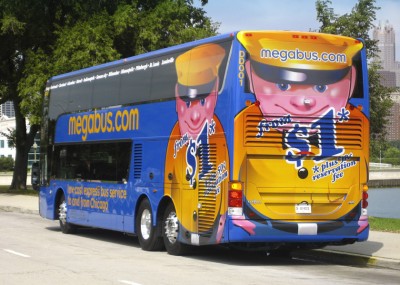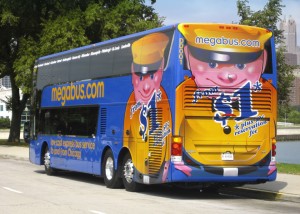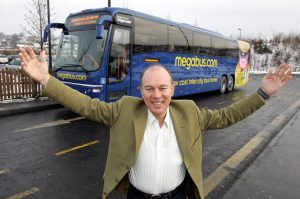

By Doug Jack
In an exclusive interview with BUSRide, Brian Souter, chief executive officer of Stagecoach Group, Perth, UK, says he is more excited about the prospects for megabus.com in North America than at any time since he and his sister co-founded Stagecoach in Scotland 30 years ago. This is a profound statement from a man not given to exaggeration, but who retains his great enthusiasm for the public transport industry.
Originally established to run express coach services following deregulation in the United Kingdom at the end of 1980, Stagecoach expanded massively by acquiring bus companies throughout the country. In 2003, the company was the first in the United Kingdom to set up a low cost, Internet-based, intercity coach service, Megabus.com, based on the low cost airline model in which prices for seats increase closer to the date of travel.
“We decided to run between Dundee on the east coast of Scotland and Glasgow (a distance of about 80 miles,” says Souter. “We bought two 40-foot mid-life double deck buses from Hong Kong, fitted them out with coach seats, and proofed the concept. The drivers nicknamed them the “slug” and the “snail”, because one could do 53 miles per hour and the other 55 miles per hour.”
Megabus.com quickly caught the imagination of customers in the United Kingdom, leading to investment in new coaches. Nowadays, 73 vehicles, nearly all 49-foot Volvo Plaxton single deck vehicles serve 60 towns and cities throughout the country. They are fitted with 64 reclining seats and have a washroom at floor level at the rear.
“We then decided to take Megabus.com to the United States, starting in Chicago in 2006,” says Souter. “We used the existing facilities of Coach USA and branded some of their vehicles in megabus.com colours. We took a loss in the first year, broke even in the second year and were making money by the third year.”
Souter believes that this was the first coach company in North America to establish an operation based on the low cost airline model, with fares starting from as little as $1 plus a booking fee.
North America
Megabus.com started in North America with 45-foot single deck coaches, of which 43 are still in use. However, the project really took off with the introduction of the luxurious TD925 Van Hool double deck coaches built in Belgium. Megabus currently has just over 100 double deck coaches in service and another 60 on order with Van Hool for 2011.

“They transformed the business,” says Souter. “They have proved to be very reliable and fuel efficient. They use about half a mile per gallon more fuel than a single deck coach, but compared seat for seat, the TD925s are 30 percent more fuel-efficient. The carbon footprint per passenger per mile is far lower than any other form of transport, and that is important to many of our consumers.”
Souter says the market for budget travel has bucked the trend of the wider economy and the company has created more than 250 jobs over the past two years. More than 7.7 million passengers have now travelled with the service in the United States and Canada since 2006, and it is now carrying more than 250,000 passengers a month.
Brian is full of enthusiasm when talking about the business in North America.
“Fundamentally, we cracked something that has never been done before,” he says. “We got people out of their cars and de-stigmatised the coach. Customers are happy to take Megabus from point to point with all the benefits such as WiFi. This is a great achievement considering the very high levels of car ownership. We encourage the use of park and ride sites so customers can use Megabus services.”
Megabus.com now covers nearly 50 cities from hubs in Chicago, New York, Philadelphia, Washington, D.C. and Toronto. Souter noted that with passenger demand so strong in North America last year, Megabus will continue to expand its range of destinations. With sales last year of more than $100 million, Megabus is expressing ambitious plans for expansion.
Asked what he sees as the future for Megabus in North America, Souter believes the company has not saturated its footprint, saying he has identified a number of further services Megabus will rollout later this year.
“I believe there is an opportunity to take megabus.com into other areas where we are not currently active,” says Souter. “My inclination is to do that by entering into exclusive operating agreements rather than by acquiring fleets. I am still thinking about how best to proceed, but we seem to have two options.”
He says the first is to find contractors who are prepared to provide vehicles that meet the Megabus specification and to run them on Megabus routes and schedules at an agreed fixed rate per mile, with Megabus taking the risk on revenue.
The other option is for Megabus.com to charge an access fee to their website, booking systems and all the support that goes behind it, with the contractor taking the profits or risks from the revenue from passengers.
Souter is open for serious discussions on these ideas.
“We know our territory pretty well, but there is nothing like local knowledge for potential partners who are interested in taking Megabus to other parts of the continent,” he says. “Look how far we have come in just five years. We have found a winning formula and there are great opportunities for growth.”
Stagecoach
Stagecoach developed Megabus around a series of hubs, looking very carefully at departure times. Consumer driven schedules with good timings are very important. A high percentage of departures are off-street, but Megabus does use some coach stations.
“We have also analyzed how our customers previously made their journeys,” says Souter. “Sixty percent previously used cars. Another 19 percent come from airlines and 11 percent from rail. The United States has just gone through its biggest recession in 80 years. At times like that, people like value for money. We are skilled at yield management. Our average journey is 350 miles and our average fare is $18.”
According to Southwest Airline’s website its average mileage is 650 with an average fare of $119.
“Southwest Airlines is one of our main competitors, but we are developing new hubs and offering direct services that have not previously been available,” says Souter. “For instance, a passenger can take Megabus direct from Philadelphia to Boston or Toronto. Coaches run direct from city center to city center with none of the hassles of airport security.
Doug Jack is with Transport Resources in the United Kingdom
